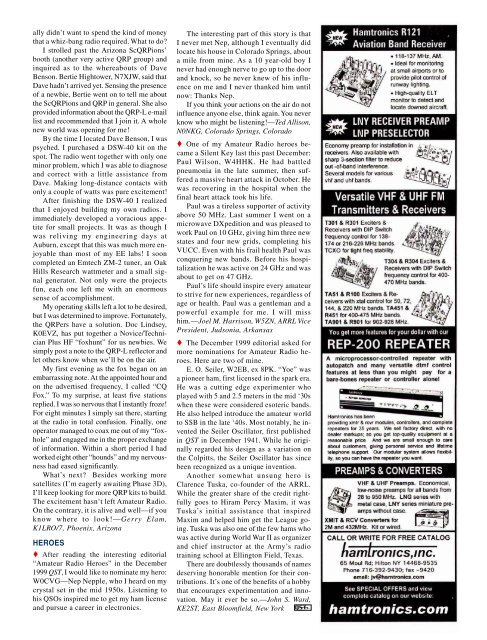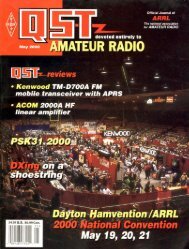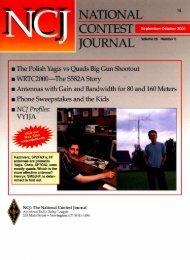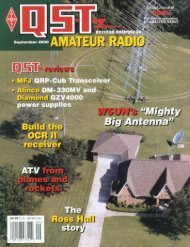CORRESPONDENCEYour opinions count! Send your letters to “Correspondence,” ARRL, 225 Main St, Newington, CT 06111.You can also submit letters by fax at 860-594-0259, or via e-mail to: qst@arrl.org.We read every letter received, but we can only publish a few each month. We reserve the right to edit your letter for clarity,and to fit the available page space. Of course, the publishers of <strong>QST</strong> assume no responsibility for statements made by correspondents.RESTRUCTURING—REACTIONS As I look at FCC’s license restructuringReport and Order, what strikes me is the greatfreedom that the FCC has given the amateurcommunity to decide its own fate. Clearly theFCC feels that demonstrated expertise inMorse code is not a prerequisite to full operatingprivileges. But what do they feel shouldbe a prerequisite? They aren’t telling us—leaving that for us to decide for ourselves.The FCC has said only that there must bea specific number of questions for eachexam, and also a minimum number of correctanswers. Previously, the FCC had specifiedthe makeup of the questions in the examby requiring a specific number of questionsin each category. That requirement has nowbeen eliminated. So, who decides the makeupof the exam questions? The VECs do. Andwho agrees on the questions in the pool thatthe exam is drawn from? Again, the VECs.We, as Amateur Radio operators, workingthrough the VECs, now have broadlatitude to determine what the knowledgecriteria for operating privileges should be.We should use this new freedom wisely—Steve Auyer, N2TKX, Liverpool, New York The more things change, the more theystay the same. I was reading through someold <strong>QST</strong>s recently. In the January 1960issue, amidst the exciting news that we hadkept our frequencies in the just concludedGeneva conference, and that our ranks hadswelled to over 200,000, there was this gemfrom WA2BMB in the correspondencecolumn:“We have all heard the screams abouthow crowded our bands are. More and morefrequencies are given to the broadcastingfield. The whole cause is that it is quite easyfor anyone to get an Amateur Radio license.What I would suggest is taking away theNovice license. This will probably cut thenumber of oncoming amateurs by betterthan 95%. I would [also] suggest cutting thecode speed required to pass a General toabout 10 WPM. In due time our bands willagain be at peace and all of us can pursueour hobby without struggle.”Well, it took 40 years, but the FCC hasfollowed WA2BMB’s tongue-in-cheek (Ithink!) suggestions. Time will tell if this isthe last desperate death rattle for AmateurRadio, or the heralding of a fresh start for the<strong>2000</strong>s. I hope it’s the latter. I’m not opposedto the changes, but I’m just not sure they’llbe enough to counter the threats to our fre-24 <strong>March</strong> <strong>2000</strong>quencies and the technological changes thatthreaten to make us irrelevant.—Brian Wood,W0DZ, Loveland, Colorado I have never written to a magazine before,but I couldn’t keep quiet this time. I consideredwriting a response to “CW Frustration”in the December 1999 <strong>QST</strong>. I was going to extendwords of encouragement to continue topractice the code. I just got my Amateur Extraticket in December 1999 after 2 years of practice,practice and more practice. Then, beforeI could get a letter into the mail and not even 2weeks after my upgrade, the FCC issued itsrestructuring Report and Order. A 5-WPMmaximum CW testing speed? What a joke!Am I extremely disappointed? You bet.Do I feel slapped in the face? You bet. Asfar as I can see, Amateur Radio has justbeen turned into CB radio. Is this how theARRL is looking out for the hobby? I haveenjoyed radios and electronics for manyyears and the code presented a challenge. Ibelieve this move will have more hamsleaving the hobby than entering.—LarryGump, KE6LG, Covina, California When the Report and Order was handeddown by the FCC on December 30, 1999, Iknew this is a great day for AmateurRadio! I could not have asked for anythingbetter. It is almost precisely what I havecampaigned for to save ham radio.Actually, I suggested two grades of license,Beginner and Advanced. Adding Extra isokay with me. Reducing the Morse requirementto the ITU minimum of 5 words perminute will end the controversy—eventually.The old timers can stew in their juices overthis “dumbing down” issue, which it is not,and the others who have viewed code as thedoor that blocked their entry to full enfranchisementcan finally have their day. Anyonecan pass a 5 WPM test. It just means that youknow the Morse alphabet, nothing more.Now we who teach the classes and givethe VE testing can say that the franchise ofHF operation is open to all and get thishobby back to what it was when getting alicense was the easy part.—Rich Davidson,K9RD, Lake Forest, Illinois I have been licensed since 1967 when Iwas 16, and I currently hold a TechnicianPlus ticket. I have wanted a General licensefor 33 years and have never been able toearn it because I can’t copy Morse beyondabout 12 WPM. I have tried classes, listenedto tapes for months on end, workedlive QSOs on the Novice bands day afterday and still can’t pass the code test. Overthe years I lost interest and rarely operated.I’ve listened to the HF bands from timeto time and I’ve found that they are filledwith profanity, racism, intolerance andmean-spirited behavior—all courtesy ofhams who managed to pass the Morse testrequirement at 13 WPM and higher. Youwizards of code, Holders of the SacredTrust and Defenders of the Old Order,haven’t kept the Infidels at the gate, theynow dwell among you! The plain truth isthat your sacred code hurdle didn’t work.License restructuring is a reality. Get overit! I intend to dust off my HF rig, refurbishmy antennas and get ready for April 15 whenI qualify for a General ticket! That ticket isnot a gift to me, it is a gift to our hobby. I’mgoing to study for an Amateur Extra as soonas the new question pool is available.My interest in Amateur Radio has beenreignited, and I’m sure I’m not the only one.It’s time for the Old Guard to step aside.Let’s see what some new blood will do tomake our hobby better than ever.—SamSachs, WB3JYL, East Windsor, New JerseyKIDNAPPED BY QRP I am relatively new to ham radio. In <strong>March</strong>1999 I was licensed as a Technician, and upgradedin May to Technician Plus. Like mosthams, I started looking for a specialty thatwould be both challenging and rewarding.I began by working AMRAD-OSCAR27, the FM repeater satellite. Fun as it was,I knew that I wanted to expand my horizonsto HF. I soon decided that I needed topurchase an HF transceiver.My friends suggested that conduct my radiohunt at the 1999 Fort Tuthill hamfest, justup the interstate from Phoenix. I did a Websearch and found a site that had Fort Tuthillinformation. The site was sponsored byNorCal, a club devoted to low-power QRPhamming. The idea of communicating on HFwith only a few watts was intriguing! As I exploredthe NorCal site I learned that DaveBenson, NN1G, of Small Wonder Labs, wouldbe at the hamfest with his DSW-40 transceiver.After a quick visit to Dave’s site, I decidedthat if I didn’t purchase a full-featured rig, aQRP radio might make an interesting alternative.It was a lot less expensive to boot!The fateful weekend arrived and I headedto Fort Tuthill with my checkbook in onepocket and a credit card in the other. After15 minutes of shopping I decided that I re-
ally didn’t want to spend the kind of moneythat a whiz-bang radio required. What to do?I strolled past the Arizona ScQRPions’booth (another very active QRP group) andinquired as to the whereabouts of DaveBenson. Bertie Hightower, N7XJW, said thatDave hadn’t arrived yet. Sensing the presenceof a newbie, Bertie went on to tell me aboutthe ScQRPions and QRP in general. She alsoprovided information about the QRP-L e-maillist and recommended that I join it. A wholenew world was opening for me!By the time I located Dave Benson, I waspsyched. I purchased a DSW-40 kit on thespot. The radio went together with only oneminor problem, which I was able to diagnoseand correct with a little assistance fromDave. Making long-distance contacts withonly a couple of watts was pure excitement!After finishing the DSW-40 I realizedthat I enjoyed building my own radios. Iimmediately developed a voracious appetitefor small projects. It was as though Iwas reliving my engineering days atAuburn, except that this was much more enjoyablethan most of my EE labs! I sooncompleted an Emtech ZM-2 tuner, an OakHills Research wattmeter and a small signalgenerator. Not only were the projectsfun, each one left me with an enormoussense of accomplishment.My operating skills left a lot to be desired,but I was determined to improve. Fortunately,the QRPers have a solution. Doc Lindsey,K0EVZ, has put together a Novice/TechnicianPlus HF “foxhunt” for us newbies. Wesimply post a note to the QRP-L reflector andlet others know when we’ll be on the air.My first evening as the fox began on anembarrassing note. At the appointed hour andon the advertised frequency, I called “CQFox.” To my surprise, at least five stationsreplied. I was so nervous that I instantly froze!For eight minutes I simply sat there, startingat the radio in total confusion. Finally, oneoperator managed to coax me out of my “foxhole”and engaged me in the proper exchangeof information. Within a short period I hadworked eight other “hounds” and my nervousnesshad eased significantly.What’s next? Besides working moresatellites (I’m eagerly awaiting Phase 3D),I’ll keep looking for more QRP kits to build.The excitement hasn’t left Amateur Radio.On the contrary, it is alive and well—if youknow where to look!—Gerry Elam,K1LRO/7, Phoenix, ArizonaHEROES After reading the interesting editorial“Amateur Radio Heroes” in the December1999 <strong>QST</strong>, I would like to nominate my hero:W0CVG—Nep Nepple, who I heard on mycrystal set in the mid 1950s. Listening tohis QSOs inspired me to get my ham licenseand pursue a career in electronics.The interesting part of this story is thatI never met Nep, although I eventually didlocate his house in Colorado Springs, abouta mile from mine. As a 10 year-old boy Inever had enough nerve to go up to the doorand knock, so he never knew of his influenceon me and I never thanked him untilnow: Thanks Nep.If you think your actions on the air do notinfluence anyone else, think again. You neverknow who might be listening!—Ted Allison,N0NKG, Colorado Springs, Colorado One of my Amateur Radio heroes becamea Silent Key last this past December:Paul Wilson, W4HHK. He had battledpneumonia in the late summer, then suffereda massive heart attack in October. Hewas recovering in the hospital when thefinal heart attack took his life.Paul was a tireless supporter of activityabove 50 MHz. Last summer I went on amicrowave DXpedition and was pleased towork Paul on 10 GHz, giving him three newstates and four new grids, completing hisVUCC. Even with his frail health Paul wasconquering new bands. Before his hospitalizationhe was active on 24 GHz and wasabout to get on 47 GHz.Paul’s life should inspire every amateurto strive for new experiences, regardless ofage or health. Paul was a gentleman and apowerful example for me. I will misshim.—Joel M. Harrison, W5ZN, ARRL VicePresident, Judsonia, Arkansas The December 1999 editorial asked formore nominations for Amateur Radio heroes.Here are two of mine.E. O. Seiler, W2EB, ex 8PK. “Yoe” wasa pioneer ham, first licensed in the spark era.He was a cutting edge experimenter whoplayed with 5 and 2.5 meters in the mid ‘30swhen these were considered esoteric bands.He also helped introduce the amateur worldto SSB in the late ‘40s. Most notably, he inventedthe Seiler Oscillator, first publishedin <strong>QST</strong> in December 1941. While he originallyregarded his design as a variation onthe Colpitts, the Seiler Oscillator has sincebeen recognized as a unique invention.Another somewhat unsung hero isClarence Tuska, co-founder of the ARRL.While the greater share of the credit rightfullygoes to Hiram Percy Maxim, it wasTuska’s initial assistance that inspiredMaxim and helped him get the League going.Tuska was also one of the few hams whowas active during World War II as organizerand chief instructor at the Army’s radiotraining school at Ellington Field, Texas.There are doubtlessly thousands of namesdeserving honorable mention for their contributions.It’s one of the benefits of a hobbythat encourages experimentation and innovation.May it ever be so.—John S. Ward,KE2ST, East Bloomfield, New York<strong>March</strong> <strong>2000</strong> 25
- Page 6 and 7: March 2000 Volume 84 Number 3David
- Page 11 and 12: THE AMERICAN RADIORELAY LEAGUE INC
- Page 14: Get to Know Your Section ManagerThe
- Page 18: Senate CommerceChairman andPresiden
- Page 22 and 23: GEORGE DOMINICK, W4UWCLooking for a
- Page 30 and 31: By Stephen Stuntz, N0BFImagine ridi
- Page 32 and 33: By David A. Rosenthal, N6TSTDXing W
- Page 34 and 35: It was a ham’s dream, sitting onM
- Page 36 and 37: always start at the beginning of me
- Page 38 and 39: An insideview of theQRSerprototype.
- Page 40 and 41: Kits and BoardsWhile the original T
- Page 42 and 43: TT2 PerformanceKeying quality with
- Page 44 and 45: Figure 1—Schematic of the meter-m
- Page 46 and 47: Figure 1—Schematic of the Simple
- Page 48 and 49: tacts I had while using this transm
- Page 50 and 51: chandisers are free to develop “s
- Page 52 and 53: WORKBENCHPROJECTS AND INFORMATION F
- Page 54 and 55: THE HELP DESKSchematic Symbols52 Ma
- Page 56 and 57: paddle. This can be done with eithe
- Page 58 and 59: creator) was providing free PSK31 s
- Page 60 and 61: By H. Ward Silver, N0AXTest Your Kn
- Page 62 and 63: HINTS & KINKSA SIMPLE ANTENNA FLIPP
- Page 64 and 65: By Dave Patton, NT1N2000 Annual Mee
- Page 66 and 67: The Board welcomed three new Vice D
- Page 68 and 69: Craigie nominated Mr. Butler. Mr. B
- Page 70 and 71: D.C., with the specific responsibil
- Page 72 and 73: Table 1Elecraft K2, serial number 0
- Page 74 and 75:
two inductors. Don’t let this hap
- Page 76 and 77:
Like most transceivers these days,
- Page 78 and 79:
Table 2Alinco DJ-V5TH, serial numbe
- Page 80 and 81:
FCC NewsENHANCED AMATEUR ENFORCEMEN
- Page 82 and 83:
tem is not legal to use as it’s c
- Page 84 and 85:
chance to do it. It may be several
- Page 86 and 87:
officials and the hundreds of train
- Page 88 and 89:
THE WORLD ABOVE 50 MHZDr. Ernest K.
- Page 90 and 91:
EME AnnalsEME (moonbounce) standing
- Page 92 and 93:
DIGITAL DIMENSIONWinLink 2000: A Wo
- Page 94 and 95:
From the Mailbag…Throughout the y
- Page 96 and 97:
AT THE FOUNDATIONSpringing with New
- Page 98 and 99:
(156.7 Hz), 146.52. Adm: $2. Tables
- Page 100 and 101:
It is with deep regret that we reco
- Page 102 and 103:
CONTEST CORRALFeedbackIn the 1999 A
- Page 104 and 105:
By Dan Henderson, N1NDContest Branc
- Page 106 and 107:
Affiliated Club Competition Results
- Page 108 and 109:
1999 IARU HF WorldChampionship Resu
- Page 110 and 111:
N5XU (+KA5WSS,KM5FA,N3TNN)390,104 8
- Page 112 and 113:
RW4AA 1,299,804 2121 172 ARW3GU 879
- Page 114 and 115:
Revised 1999 June VHF QSO Party Rov
- Page 122:
has been around for some time, is a
- Page 126:
154, WB5ZED 232. Tfc: K5WOD 4, NOKW
- Page 130:
Bethpage, NY. Bob Wexelbaum, W2ILP,
- Page 134:
NEW HAMPSHIRE: SM, Mike Graham, K7C
- Page 138:
136longtime member N6DOC. Installat
- Page 142:
tion of the digital network within
- Page 146:
DEC, EC, ASM, and cabinet member at
- Page 150:
148agencies have had a working rela
- Page 156:
CALL SIGN NAME BADGES. Club logos o
- Page 160:
COMPUTERS - WANTED early Pre-1980 m
- Page 176:
Index of AdvertisersADVERTISING DEP
















